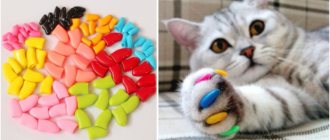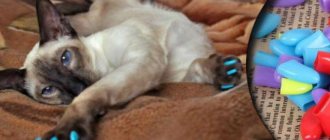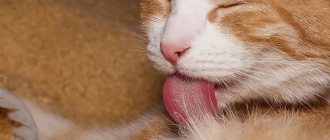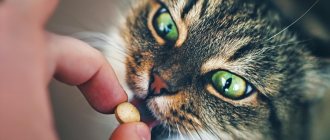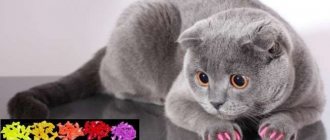What will you learn from the article?
- What are anti-scratch pads? Basic questions about anti-scratch products from cat owners
Anti-scratchers for cats were invented by American veterinarian Toby Wexler to prevent declawing surgery. From the article you will learn what they are, how to use them, and consider what offers are on the market. It’s a pity that in the USA and Europe they have been known about them for about 15 years, but they are just coming to us. That's how many cat paws could have been saved.
The main thing is that unlike declawing surgery, nail caps will not change behavior or harm your pet's health. The animal retains all its natural instincts, and the cat continues to enjoy life.
This is simply a miracle solution for those who love not only their furniture, but also their pet.
The effect of caps on nail growth
The protective device does not bring any benefit to the animal, but it does not harm the body either.
Rubber products are glued to the last third of the nail plate, the growth area is not affected. Nails grow naturally without any obstacles. When putting on cat nails, owners should be careful not to get any glue on the skin. In such places, cracks may form - entry points for infection.
Also, the adhesive composition can cause allergies. At the first sign of it, the pet is taken to the veterinarian. Cases are extremely rare, as manufacturers use non-toxic materials.
For your information! Even if your cat swallows the pad, there is no need to worry about harming its health.
Answers to common questions
Question: Do cats' claws itch and hurt under the pads?
Answer: No, just like nails with ordinary varnish on the fair sex. Cats' claws can be trimmed; they tear them off on scratching posts themselves, and it doesn't hurt them.
Question: Will anti-scratch pads affect a cat's gait?
Answer: Possibly. At first, when your four-legged pet is just getting used to the “decoration,” it may move stiffly. Then the gait becomes the same as before.
Question: Do the caps interfere with the retraction of natural claws?
Answer: Possibly, but only if the owner was too lazy to read the instructions for gluing anti-scratch pads for cats. Let us repeat: the cap should only be placed on the part of the claw that always sticks out from the pad. Don't tuck your pet's entire claw in.
Question: If a cat spends part of its time inside the house and part outside, can anti-scratch products be used?
Answer: Definitely not. Claws are the main cat weapon. If you let an animal go outside, at least sometimes, then it should not be left without protection. Neither hunt nor fight back a cat or dog. This way, the pet can be seriously injured or even killed, because it will not be possible to climb up the tree trunk.
Question: how to remove anti-scratch pads?
Answer: Usually after 1.5 or two months the caps fall off on their own. If a cat's horny cover changes at a fairly accelerated pace, then this process occurs even faster. In just a couple of weeks.
If you take into account the price of anti-scratchers for cats and compare it with the cost of a scratching post, it turns out that it is more profitable not to torture the animal and teach it to sharpen its claws in a specially designated place. By the way, for this they use special safe compounds that attract the attention of cats.
Question: By the way, how much do multi-colored caps for cat paws cost?
Answer: Usually the price of anti-scratch for cats is in the range of 250-400 rubles per set. But specific prices depend on the place of purchase, brand and other factors.
Question: What's included, only anti-scratch pads?
Answer: As a rule, the kit includes 20-40 silicone caps, a tube with special glue, and instructions.
One set is designed to last up to about a couple of years. If you use them constantly, but you will need to change systematically only the pads on 1-2 claws. The glue also lasts for approximately two years. Does not deteriorate or dry out if stored properly in a tightly closed tube.
Despite the fact that instructions are included with the package, not everyone can perform these simple steps, if only because the animal behaves quite playfully or aggressively. And it turns out that you can get even more scratches due to these anti-scratches than if you leave the animal alone. In this case, you should not torture either yourself or your pet. It is worth contacting a specialist who knows how to behave with the animal so as not to injure him and put the caps on correctly.
So, weigh the pros and cons before purchasing nail guards and putting them on your pet’s paws. Think about the need to do this. But if you just want to make your pet “more beautiful”, and you think that it’s as pleasant for her as a fresh manicure is for you, it’s definitely not worth it.
- Cat and cat claw care
- We cut the cat's nails
- How to accustom a cat to a scratching post?
Plastic anti-scratch pads.
An alternative to “soft paws” may well be other anti-scratch products - Soft claws, which were invented by the American veterinarian Tobby Wexler to stop the orgy of cutting off cats’ toes 25 years ago, when the operation was still allowed in the USA.
It would seem that it’s easier?! – Each small dagger must have its own personal plastic sheath! Nail claws, so to speak, or claws. The first word is correct according to the rules for composing words in the Russian language, the second - according to the reflection of application. And it sounds somehow nicer!
However, in Russia they are still wary of the use of nail caps. Why? After all, this is a real life hack (life “life” + hack “hacking” in English) of our time! A godsend for those who want to have a purring creature nearby, but fear for the integrity of upholstered furniture! And protecting furniture is by no means the main task of claw thimbles; the range of their “responsibilities” is much wider!
Anti-scratch cost
The price of such devices is low. One package costs on average from 300 to 400 rubles. The cost of false claws depends on the quality of the materials used, the manufacturer and the pricing policy of a particular pet store. The kit may include 40 or 20 nozzles, special glue and instructions. One package can last for several months or even years, since the attachments are often replaced not on all claws, but only on 1 or 2. The glue is suitable for use for two years. Considering these factors, anti-scratch devices can be called a budget invention.
What are anti-scratch products for cats?
anti-scratch caps
Thanks to the special shape of the anti-scratch pad, it is very easy to put on the cat’s claws, and they will not allow her to feel any discomfort. Immediately after this, you can start playing with your pet without fear of glowing scratches appearing on your body. What’s especially nice is that you will be provided with such protection for 2 to 8 weeks.
The idea for this invention came from the American veterinarian Toby Wexler. And, it must be said that the American population has been using anti-scratch products for their cats for the past 15 years.
Domestic furry owners were able to get acquainted with them only recently. And this is sad, since any owner who first became acquainted with this device finds it difficult to come to terms with how he previously managed without them.
Anti-scratch products will help every owner protect furniture from damage forever, as well as keep wallpaper on the walls intact. Anti-scratch guards look like silicone caps that are placed on your pet’s claws using medical glue. To prevent the animal from experiencing pain, manufacturers offer cat owners anti-scratch pads of different sizes and different colors.
Therefore, you can easily choose the appropriate device for your pet, taking into account its age. Only small kittens that are not even 6 months old can do without them. These babies have underdeveloped claws that have not yet hardened.
You also need to take into account their active lifestyle, because during games they can easily sharpen their claws without them. Elderly cats, who no longer need to frequently keep their claws sharp, can also live peacefully without anti-scratch protection. Animals that do not fall into one of these groups are encouraged to have this device.
How long does the device last?
Therefore, at a certain point, the cat’s claws will also remain without caps. Therefore, owners will have to regularly change the caps as the cat’s claws grow.
- Typically, the time required for claw growth is about 1.5–2 months. It is with this frequency that the caps for the claws will have to be renewed.
- A standard anti-scratch kit includes about 40 caps and a tube of glue that remains usable for 2 years or more.
- Anti-scratch devices have a very simple design. If you decide to use them to protect only the claws on your front paws, you can use one set 4 times.
Anti-scratch pads have universal sizes, so they can be used effectively not only for two- to three-month-old kittens, but also for adult animals that have lived in your home for several years.
If necessary, you can always reduce the length of the caps by cutting them to the desired size if you make a mistake when purchasing. Modern anti-scratch pads can come in a variety of colors, which include 6 different colors, ranging from transparent to red and orange.
What sizes are the caps produced?
Anti-scratch products can be used for animals of different sizes and ages, so for each group there are products in several categories.
- If you are looking for caps for small kittens up to 6 months of age and weighing between 0.5 and 2 kg, then size XS will suit you. In principle, these babies can easily do without them, but if they wish, the owners can buy them.
- If you have an older cat weighing between 2 and 4 kg, then you should purchase products in size S.
- Owners of larger animals weighing between 4 and 6 kg are advised to select caps in size M.
- If you have a particularly large cat at home, for example a Maine Coon weighing more than 6 kg, then you should choose caps from those that are size L.
Contraindications
They don’t use overlays
- Kittens will not need caps until they are 6 months old. Soft claws wear down naturally and do not cause serious damage.
- Nozzles should not be used on a cat that roams freely without supervision. The owner exposes the pet to mortal danger; wearing the pads, the cat becomes defenseless against possible opponents. The animal will not be able to defend itself with its paws and will not climb a tree to escape the dog.
- They refuse pads if they notice signs of individual intolerance to the components of the adhesive or material: redness, irritation, swelling on the pads.
- Elderly animals often stop sharpening their claws; they do not need anti-scratches.
Cats remove objects with small holes and thick pile from the access area where the nozzle can easily get stuck. The cat pulls its paw in an attempt to free itself, injuring its claw.
Does it cause inconvenience to animals?
It is difficult to unambiguously answer the question about the convenience of anti-scratch for an animal, since the reaction of each of them to such “shoes” can be completely different.
With regard to the comfort of owners, the following questions are most often concerned:
- glue safety. To attach the pads, non-toxic medical glue is used, which is used in cosmetic surgery in humans, and therefore does not pose a risk to the health of the animal. However, it is always worth considering that an individual reaction is possible;
- itching and pain under the caps. The overlays are placed on the insensitive, keratinized part of the nail, therefore they cannot cause pain or other unpleasant sensations;
- change in gait or paw position. Manufacturers and veterinarians assure that the pads cannot affect the gait and position of the paws; with anti-scratch pads, the animal is just as playful and active;
- influence on the animal's psyche. When using anti-scratch products, the cat does not have a feeling of defenselessness and vulnerability, therefore there is no negative impact on the psyche.
Do you know how many years cats live at home?
On the other hand, it is worth considering that wearing claw covers may make it inconvenient for an animal to itch, clean its ears, and perform hygiene. Also, if your pet is active and likes to explore heights in the house, he may easily slip and fall without being able to cling with his claws. Due to anatomical features, some animals have claws that are not fully or not retracted at all, which can cause discomfort.
To prevent your cat from scratching furniture, make her a scratching post. Also, your pet’s claws need to be trimmed periodically.
Declaw removal. Onychectomy
The first method is lousy in its essence, but works 100% for those who purchase a living creature (cat) as an architectural decoration of an apartment design - onychectomy. This “remedy” is resorted to by those furniture owners who want to keep it intact in exchange for the suffering and health of the animal that has trusted them.
The essence of the method is an operation to remove a cat's claw along with part of the finger without medical indications. The horny formation on the last phalanx of the finger in most vertebrates is called a claw or nail. By looking at your hands, you will see how nails differ from claws.
A common fact is that in order to completely get rid of a nail-claw and prevent its growth in the future, it is necessary to cut off the part of the finger on which this horny formation “grows.”
If after such an intervention a part of the phalanx remains, then the claw will grow again, but the horny plate will no longer grow outward, but inside the finger, which will entail unbearable pain, the development of an inflammatory process and a new, more complex operation and long-term treatment.
Excision of the flexor-extensor ligament of the claws (after the operation the cat cannot extend and retract its claws) does not carry anything “new” in comparison with onychectomy itself: the same anesthesia, the same scalpel or forceps, the same pain, the same high probability of recovery tendons.
Consequences of onychectomy
Surgical intervention is followed by irreparable changes in the cat’s condition, such as constant pain, stress, dysfunction of the musculoskeletal system, loss of coordination, osteomyelitis, arthritis, etc.
Since the cat, when walking, relies on the tips of the first phalanges of the fingers and the edges of the claws, after removing the phalanges, it will no longer be a ballerina - it will have to learn to walk again, shifting the main emphasis when stepping to the pad of the paw.
Having accustomed its body to move like a bear, the cat will disrupt the natural, given to it by nature, uniform load between the muscles of the body, as a result of which some of the muscles will be overworked, and others will begin to atrophy. Where is the elegance and grace of a panther! I wish I could get to the bed, overcome the persistent pain in my stumps and throughout my body!
By the way, it is very painful to rake out the litter in the tray with a burning, aching paw; many cats simply refuse to follow the rules of hygiene after onychectomy.
Having realized that they can no longer use their claws, cats often begin to use their last remaining means of defense - their teeth. Considering the deteriorated nature, due to constant pain, teeth are used much more often than “zealous” furniture owners would like.
Often unfortunate animals are thrown out onto the street, since being next to an aggressive and “disgusting” animal becomes simply unbearable, and then a quick and often painful death from hunger or the first stray dog.
The only thing that benefits from all this is the sofa and new wallpaper. The worst thing is that the second generally accepted name for this inhumane action sounds mockingly affectionate - “Operation anticorpi or soft paws”.
Reviews from veterinarians about such unauthorized interventions in the body of a healthy animal at the whim of the owner are extremely negative. And any doctor who respects his profession should not promote the scalpel, patting his pocket (the cost of the operation is from 3 thousand to 8 thousand), but try to dissuade the unreasonable owner from an operation that will make a healthy animal crippled for life.
Today, such fanaticism is not prohibited by law in Russia and other neighboring states.
In the USA, the doctor and the owner can be jailed for a certain period of time under the article “cruelty to animals.” In the UK, you will get off with a large fine and license suspension for up to 5 years. In many countries, cats that have undergone surgery are permanently removed from the show ring.
Product Description
This is a very soft silicone protection for the claws. The anti-scratch product is fixed with a special non-toxic glue. Gluing the anti-claws is quite simple. The adhesive mass hardens almost immediately. The procedure itself does not cause pain and does not cause any harm. In some cases, the caps may irritate the animal in the first days, but this quickly passes.
Anti-scratch pads for kittens and cats are produced in four sizes, which are always indicated. Choosing the right one is the most difficult because you have to determine it by eye. Available sizes:
- L - designed for large pets weighing more than 6 kg.
- M - for cats weighing 4-6 kg.
- S - for cats weighing 2-4 kg.
- XS - needed for small kittens less than six months old and weighing 0.5-2 kg.
Caps are available in almost any color. You can buy pink, blue, purple, orange, red, yellow anti-scratch pads. Also available in black and natural colors.
The caps will naturally fall off your pet's nails as they grow. Exactly how long the product will last on a cat depends only on its activity and behavior in general.
Owner stories
Larisa: “I bought my kitty glamorous pink “cat scratchers.” I had a hard time getting used to it, I exhausted the cat and myself when I glued it for the first time. A day later, the cat chewed off one cap, then two more. I had to redo it. This situation repeated itself 2 more times. Then the cat got tired of fighting and no longer chewed on the pads. What can I say? The glue holds the caps very tightly. It is also difficult to wipe off from your hands. You also need to accurately guess the size. We bought the XS for our one-year-old tartan, but it turned out to be too big for her. I had to trim the pads."
Sophia: “The problem of sharp claws arose with the arrival of a small child in the house. I looked at and ordered ultra-thin claw attachments from MIKOO through the online store. I chose the Medium size, it is for animals weighing 4-6 kg. Just for my cat. The package contained 20 pads, instructions and glue. The cat really didn’t like what I wanted to do to her. When the first three claws were glued, she watched intently. Then she began to break free and bit me. The cat wore the anti-scratch pads for about 3 weeks, then they began to fall off one by one.”
general information
Let's start with public opinion, or more precisely, with three categories of opinions. As you understand, the owners choose one that is acceptable to them and stick to it. So, the first group considers anti-scratch caps to be a harmful accessory on which Chinese manufacturers make money, the second group is of the opinion that anti-scratch caps are an integral part of maintaining order in the house, and the third group considers caps to be decorations and nothing more.
I don’t want to argue with the first group, but it’s worth stating one fact. Anti-scratch devices were invented not by the Chinese, but by the Americans, that is, the patent for the accessory belongs to the United States. The idea came from veterinarians who were looking for an alternative to declawing. By the way, this, to put it mildly, inhumane procedure was also “invented” in the USA. Many countries have banned animal declawing at the legislative level; the American government has not introduced such bans, but owners have been offered an alternative. The conclusion is that “profiteering” is taking place, since declawing and claw padding are two expensive procedures that cat owners resort to.
The next point is the ambiguous presentation of your product on the market. Consumers are confident that the caps are designed to protect furniture and wallpaper from scratching. Anti-scratch products should not be used for a long time, and scratching is one of the forms of normal behavior of cats. Even the instructions for this accessory contain a warning that the caps need to be changed and the cat’s claws need to be looked after (since the cat is deprived of such an opportunity).
In fact, anti-scratch pads were invented as a temporary solution to the following problems:
Avoiding pet fights during the adaptation period - if you decide to get a kitten or puppy, an adult may become jealous of cats
If the owner works and cannot control the behavior of the pets, the older cat is given anti-scratch guards for 1–2 weeks.
Adaptation period to a child – cats are known for their intolerant attitude towards those who distract the owner’s attention. Very often the subject of a pet’s dissatisfaction is a baby that appears in the house.
During the adaptation period of 1-2 weeks, while the cat gets used to the new family member, she is given rubber caps to ensure that the baby is protected from scratches.
Repair is a very stressful situation for a cat, which can lead the pet to attack not only strangers (workers, guests), but also the owners. With the right approach, the pet will adapt to the new environment in a few weeks, and during this time, anti-scratch treatments are used to avoid serious attacks.
Education - many people decide to adopt an adult cat, whose character may need adjustment. For the period while the pet gets used to the new environment, the tray, scratching post, all family members use anti-scratch pads as guaranteed protection against attacks.
Dermatitis and other skin diseases that cause itching - if the face is affected, you can use a collar, but if the disease affects the body, the cat will quickly scratch the skin to the point of wounds. To protect your pet from secondary skin infection and speed up the healing process, use silicone claw pads.
The conclusions are obvious - wearing caps is a forced and temporary measure. In such situations, you can and should use rubber caps.
We’ll talk about how to choose and put on claw pads a little later.
It's time to pay attention to the myths and facts about using anti-scratch products
Cat claws Glamorous paws WHITE
The price is valid only when placing an order in the online store.
Product availability in the ZooPark retail chain as of: 08/22/2020 18:30:00
Warehouse - NO Novokuibyshevsk - NO Ladya shopping center - NO Zakhar shopping center - YES Airplane shopping center - NO Megacity shopping center - NO Chernorechenskaya 38 - NO 9-Proseka - YES Revolutionary 137 - NO Michurina 138 - NO Sadovaya 239 - NO Shvernik 19a - YES
Cat claws Glamorous paws WHITE. Glamor paws are protective caps that are placed on cats' claws if the animal is often scratched. They are completely safe and are the best alternative to declawing surgery. Glamorous paws will protect adults and children, sofas and armchairs, walls and wallpaper, clothes and curtains from scratches. In addition, soft false claws for cats will help give the animal a bath or give medicine without fear of getting scratched, and will also protect one cat from another. The cost of soft claws for cats is much lower than a new sofa or replacing scratched wallpaper. In addition, the soft caps on the claws look very aesthetically pleasing, decorate your pet and create a unique charm for him. Universal size. The caps are suitable for both kittens 1-2 months old and cats weighing up to 6-7 kg. Each package contains: 20 caps, 1 tube of glue and 1 instruction. One package is approximately enough for 4-6 months. The caps are made of material that is safe for humans and animals. Instructions on how to put on “Glamour Paws” correctly. 1. We make a decision. First we need to decide whether we will stick the caps on the front and hind legs, or only on the front ones. Of course, if a cat damages furniture, wallpaper, etc. , and you bought scratches in order to save the apartment, then you need to stick them only on the front paws, since these are what cats use. With this option, you only use half the caps in the box, which is a smart savings. If you want to play freely with your cat and want it to look stylish, then you need to put it on both the front and back legs. In this case, you still have two spare caps, because... Cats have four claws on their hind paws. 2. Trying on the caps. First make sure the caps will fit. Take the paw in your right hand. Lightly press the pad of the foot with your index finger, holding the top of the claw with your thumb, so as to release the claw. If the cat does not allow caps to be put on its claws, then you need to gently massage its paws several times a day, accustoming the cat to this action. Place the cap on the claw. The cap should completely cover the surface of the claw. If the cap is large, then trim it from the side of the hole. 3. Preparation and trimming of claws. To prevent the caps from being pierced, the claws should be trimmed slightly. Be very careful, you only need to trim the very edge of the claw by one or two millimeters, without touching the blood vessels that are in the claw. The service life of the anti-scratch pads can be increased by making the surface of the claw a little rougher for better adhesion. This can be done with a nail file. The service life is also affected by treating the claws with a disinfectant and cleaning them from dirt. 4. Applying glue. Cut off the spout of the glue tube and place a pink cone on it for a clearer application of the glue. Apply glue to the inner surface of the cap. The glue should fill no more than one third of the volume of the cap
Attention! The glue can stain furniture and clothes, so prepare your work area in advance. Attach one cap first and make sure everything works out
Then fill 4-5 caps with glue at once, gluing them onto one paw at once. 5. Put the caps on the claws. Press on the pad of the paw so that the claw extends out. Place the anti-scratch caps onto your claws with a sliding motion and lightly press each cap on the sides of the claw for 5-10 seconds to fix the glue. Hold the cat in your arms for a while so that the caps have time to stick and the cat calms down a little. Fingers stained with glue can be cleaned with nail polish remover or by rubbing one hand against the other while holding them in warm water. 6. Observation of anti-scratches. Sometimes cats may try to chew off scratch guards; this is normal behavior. In this case, re-glue the cap or replace the fallen caps with new ones. After a few days the animal will stop paying attention to them. If the instructions are followed correctly, anti-scratch guards can stay on the claws for up to two months (the claws of a healthy cat are replaced every 1-2 months).
Veterinarian's opinion
Veterinarians are not so optimistic about anti-scratch products.
In any case, even in an animal with a balanced character, the procedure of gluing the caps is stressful.
It can last from several days (adaptation period) to several weeks.
Important! A cat must sharpen its claws - this is what nature intended. One can only guess how the prohibition of instinct is reflected in her psyche. The cat does not adapt to its new sensations - it simply resigns itself.
It is no longer possible to scratch furniture. How to have fun now?
After gluing the protective caps, the cat experiences tactile discomfort for a long time.
Now the animal cannot jump high or fully feel the surface on which it moves with its paws.
As for street cats - those that live in the house and have the opportunity to walk freely on the street - anti-scratch treatments are strictly contraindicated for them!
Imagine that an animal needs to quickly run away from a dog and climb a tree.
How can it, having caught its claws in the bark, do this deftly and quickly?
How can he defend himself and protect himself with a blow from a paw that has absolutely smooth caps instead of claws?
Some cat owners undergo declawing surgery for their pets.
If you choose between removal and anti-scratch, silicone caps are much less likely to injure animals.
What are anti-scratch pads?
Cat claw caps have long ceased to be something frightening and new. More and more cat lovers are leaning towards this choice. So what are they? These are silicone attachments that are fixed on the animal’s paws using special medical glue. At first, such a unit may cause discomfort to the animal. It will get angry and try to chew them off, but a couple of days will pass and the pet will stop noticing them. This is a real salvation for the furniture and hands of animal owners.
Silicone claw pads for cats come in several types:
- "XS" - suitable for babies up to six months. Such a kitten should weigh no more than 2 kg.
- “S” - for older and heavier cats - up to 4 kg.
- “M” - created for adult animals weighing no heavier than 6 kg.
- “L” - claw pads for cats of heavy breeds weighing more than 6 kg.
Important! Nail caps for cats are not suitable for purring cats who like to walk in the fresh air - this can be dangerous. This accessory blocks their only method of defense - claws.
The animal will not be able to run away from danger, climb a tree or fight back.
Silicone claws for cats do not cause any difficulties in operation: when the time comes to replace them, new ones are put on in place of the lost caps. However, everything is individual, look at the condition of the animal’s paws. If the claws have grown long enough, you should trim them a little before gluing on the next ones. Do not pour glue into the entire cavity, because it can flow onto the fingertips and cause discomfort to your pet. If your furry fidget does take off a few of them, simply replace them with new ones from the set - there are always several spare caps there.
Important! If your pet is aggressive or overly active, you should entrust the installation of claw attachments for cats to a specialist. If you want to do it yourself, each package contains detailed instructions for use.
Claw caps are not worn on very small or old cats - they simply do not need it.
Tips for use
When used correctly, one set of cat nail caps will last for two months. And the process of putting them on does not cause any big problems for the owners.
- Wipe the caps before gluing with a cotton pad soaked in an acetone-free disinfectant. This will clear the dirt and the pads will stick better.
- Use a nail file to smooth the surface of your cat's claw to make it rougher. The caps will stick faster.
- Glue stuck to your fingers can be easily cleaned with nail polish remover.
- Anti-scratch guards are usually placed on the cat's front paws. For more effective protection against scratching, caps can also be glued to the hind legs.
How to put on and take off anti-scratch boots correctly?
Before gluing the caps, you should measure them. All cats have different claws and the size of the products does not always correspond to them. In this case, they can be changed at the store where you bought them.
When you try on the caps, pay attention to how they fit on the claws. Products should fit snugly to the claws, they should not slip off
The distance of products from the base should be 3-5 mm.
How to properly wear anti-scratch guards for your pet?
It's very simple: first prepare the caps and glue, then provide the cat with a suitable environment. It is best to sit the animal on your lap and calm it down with affection and something tasty. Then you can begin the process itself.
If the cat's claws are long enough, then they should first be cut with special scissors, as you do all the time. And it is advisable to additionally treat the surface with a nail file. This is necessary for effective gluing of the overlay.
Don't forget to disinfect your claws with an antiseptic (alcohol, vodka or miramistin) and degrease them with nail polish remover. After this, squeeze a little glue (one drop) into the anti-scratch pad and lightly press the pad of the paw with your fingers, causing the claw to come out.
Place the product on the claw and lightly pinch it from the sides for secure fixation. This procedure will not take you much time. But after sticking all the claws on, it is recommended to hold the cat on your lap for a few more minutes. During this time, you can stroke and caress him. Then you can let him go.
This video shows the entire procedure for putting silicone caps on cat claws:
At first, the cat will not completely accept such “nails” and may even try to tear them off. This is an absolutely normal reaction to the presence of a foreign body.
If the cover comes off, you can glue a new one in its place.
Anti-scratch pads should be changed as soon as the renewal of the upper stratum corneum of the claw begins. This usually happens once every two months.
By the way, you can put the caps on all four paws, or only on the front ones.
If you are unable to “shoe” your cat because he scratches and bites, it is better to seek help from a veterinarian or groomer.
Advantages of anti-scratch nail guards
This invention has made life much easier for many cats and their owners!
- Such anti-scratch caps protect cat owners if their health is not in order. For example, allergies, low blood clotting, HIV, etc. A cat will no longer be able to scratch with a paw with plastic thimbles on its claws.
- Your child will be protected from attacks by a domestic predator when, having played too hard, he pulls the cat’s tail too hard. Not all mustachioed and striped people are able to forgive such familiarity towards their own person. But you definitely need to explain to your baby that this little animal is not a toy in itself, you can play with IT, not HIM!
- If, due to circumstances, you got an aggressive animal and you are only at the beginning of the path to correcting the bad character of your pet - three.
- If a young playful kitten tries to hunt and attacks everything that moves (legs, children, rags, etc.) from ambush - four.
- If jealousy of another family pet or the appearance of a new animal does not allow the cat to sleep peacefully, and this feeling tends to splash out through a series of short but furious attacks on the subject of hatred - five.
- If the cat is sick, has undergone surgery or has contracted fleas, then you can stop scratching or trying to tear off the stitches with the help of plastic anti-scratch guards - six.
- A beautiful, exquisite “claw” on the paws of the most elegant of animals - seven.
- Well, and protecting furniture from being torn apart - eight, of course.
- Living in one neat, clean living space with a beautiful and well-bred animal without loss is nine.
- No harm from wearing caps for the cat itself – ten.
Each owner, based on his own experience, can add “eleven”, “twelve”, etc., at will.
Mounting features: consequences of incorrect installation
False nails for cats are protection for the home interior and peace of mind for the owners. Do not use them on animals whose claws are still developing or have diseases. Such attachments can prevent a growing organism from fully developing and learning about the world. Older cats of advanced age do not need such accessories at all. Such pets have long lost interest in games and damaging furniture.
Many owners wonder: Is my furry friend in pain? What if he swallows them? There is no reason to worry. The cat claw attachments are made from non-toxic silicone with a soft, streamlined design for a reason. If a kitten accidentally swallows one of these, it will easily pass through the gastrointestinal tract.
At first, it may seem that using stickers on your cat’s claws is an expensive proposition. But this is only the first time. The longer your pet wears the attachments, the less he removes or chews them, which means he wears them longer. On average, replacement occurs once a month: cat nails simply fall off along with the stratum corneum naturally
If there are children living in the house, pay attention to colored stickers. Since kids love to try everything new and unusual to taste, the use of colorful accessories will help parents quickly find and remove those that have fallen off.
Note! When choosing claw pads for your pet, consider its size. Be sure to weigh your pet before going to the store.
Incorrectly attached silicone nail pads can cause ingrown nails, so make sure that they do not fit too tightly to the base. If you do not take this nuance into account, it will be painful for the animal to walk and play, it will not be able to painlessly extend and hide its claws, it will not be able to play or walk normally.
Floor scratching posts
There are different floor scratching posts - flat, columns, combined with a bed or a house. They take up a lot of space in the house, but in some cases they are irreplaceable. Flat and heavy floor mounts will help out when the wall material does not allow wall mounts to be attached to them. And you don’t want to constantly trip over light cat rags made of cardboard or fabric that the cat drags around the entire apartment. A floor-mounted claw clipper located under the table will not disturb anyone. The poles will be very good for an active and young cat if there is no place for him to climb in the apartment and there is no way to go outside. Complex complexes with houses and beds will be especially useful where there are several cats and kittens are often born. All animals will have a place to frolic, and they will not constantly get underfoot, scratch and damage furniture.
Flat floor scratching posts
Making a flat, floor-mounted cat scratching post is very easy. To do this, you need to take as a base a piece of wooden board, chipboard or multi-layer plywood 40-50 cm wide and 70-100 cm long. A part from an old cabinet is perfect for this. The base can be wrapped on both sides with carpet with a fabric base, the wrong side out. An old wool rug is ideal for this.
How to put on anti-scratch protection for a cat?
It is better to carry out the procedure of putting on anti-scratch guards with someone together, so that the second person does not let go of the cat and at the same time can stroke and calm him.
It consists of the following:
- First of all, it is necessary to trim the hair around the claws a little so that it does not stick together when glue gets on it.
- The claws themselves need to be lightly sharpened with a nail file.
- After this, each claw should be wiped with any disinfectant.
- Next, you need to press on the cat’s paw so that the claws appear and put a cap pre-filled with glue on each of them.
Important! You need to glue the anti-scratch pads on your cat very carefully. The amount of glue in the cap should be such that it does not spill out of the cap when putting it on
The cat's fur near the claw should not be touched.
The cat should not be released immediately after the procedure. It is necessary to wait some time until the glue dries and the linings are finally fixed.
At first, the cat may not be comfortable wearing such accessories, so at first it needs to be provided with attention and affection so that it becomes less nervous and anxious. During this period, she needs to be stroked more often.
The advantage of these pads is that they do not need to be removed.
During this period, she needs to be stroked more often. The advantage of these pads is that they do not need to be removed.
The anti-scratch lasts for a relatively short time.
After about a month, cats' old sections of the claw begin to fall off and the anti-scratch guards themselves will fall off along with them. After this, you can install a new kit.
Watch a detailed video about how this procedure takes place:
Which anti-scratch glue is best to choose?
The best option would be the glue that comes with the caps. This product sticks well and is safe for the cat’s body.
If the adhesive has run out and there are still caps left, you can purchase medical hypoallergenic adhesive based on cyanoacrylates. They are sold in medical equipment stores and veterinary pharmacies.
Gluing onto Supermoment and other household quick-setting building mixtures is prohibited. When using this glue, cats often have allergies. Under the pads, the claws can crack due to aggressive chemical elements.
The benefits and harms of caps
Any pet product has both positive and negative characteristics. This is explained by the peculiarity of mustaches, their individual needs and character, as well as the preferences of the owner.
Undeniable advantages
The positive aspects of wearing silicone pads are obvious, and there are quite a lot of them. The main thing is that the mustache normally perceives their presence on its paws and does not try to chew them off. Advantages of devices:
- keeping furniture, walls and curtains in good condition;
- lack of possibility of causing injury to a person;
- Can be used at any age.
Properly worn cute silicone items will not cause any inconvenience to your furry friend.
Over time, he will stop paying attention to them, and then the owner will be completely calm about the safety of his home
Possible disadvantages
Of course, there are also negative sides to using tips. However, they can be avoided with the correct selection of accessories.
It is important to consider not only the attractive appearance of the product, but also how comfortable the mustache is
The disadvantages that may arise include:
- fragility (maximum month, and average service life - 2 weeks);
- different period of adaptation - the cat may never get used to the innovation;
- they squeak unpleasantly or knock on the floor when walking or burying the tray;
- possible deformation of the nail plates, their separation.
Fluffy purrs, like people, have different mentalities. Therefore, the period of adaptation for some pets may take a couple of weeks, while others will forget about the caps in just a couple of hours.
Age restrictions
Manufacturers of products for mustachioed consumers claim that there are no restrictions on the use of stickers. However, veterinarians do not agree with this. In their opinion, it is not advisable to use kits for kittens up to six months of age. Their nail plates themselves are very soft and easily wear off when walking or playing.
Nail caps are not useful for older cats. Old people usually lose interest in curtains and pieces of furniture, so there is no point in protecting them.
The same can be said about free-ranging animals. An individual who spends a lot of time outdoors will not be able to climb a tree or protect itself from enemies if cute accessories are put on it.
Advantages and disadvantages
Compared to trimming or complete removal of claws, anti-scratch treatments have a great advantage:
- Do not harm the animal. Cats freely retract and release their claws, move, and remain playful.
- Makes caring for your cat easier. You can bathe or give medications without the risk of being scratched.
- Preserve the interior from destruction. There will be no torn furniture, wallpaper, or torn curtains.
- Do not disturb the natural growth of the claw. Gradually, the top layer of the horny plate peels off, and the claw is renewed.
But cats feel glued anti-scratch pads as a foreign body, so even the calmest animals experience stress and discomfort for several days. Due to the fact that the cat has nothing to cling to, it experiences inconvenience:
- when jumping onto high surfaces;
- when braking while running;
- during hygienic procedures (they cannot scratch themselves fully).
A cat with anti-scratch protection is defenseless on the street. In escaping, he will not be able to climb a tree or defend himself from an attack.
Another unpleasant property of anti-scratch caps is that during active movements (walking, digging a tray), the animal makes unpleasant clicking or creaking sounds.
Before you stick on anti-scratch pads, you should weigh all the pros and cons of the pads and decide whether the animal needs them.
Read also: How to use nail stickers
